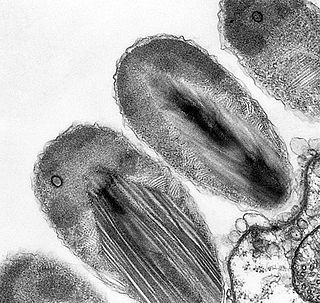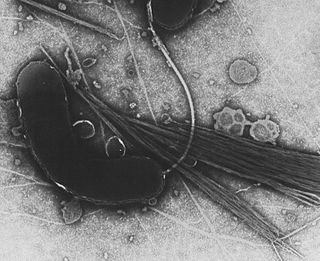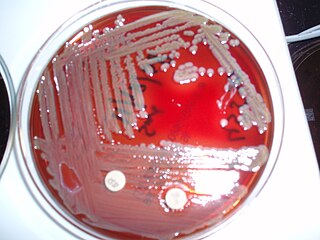Related Research Articles

Gram stain, is a method of staining used to classify bacterial species into two large groups: gram-positive bacteria and gram-negative bacteria. It may also be used to diagnose a fungal infection. The name comes from the Danish bacteriologist Hans Christian Gram, who developed the technique in 1884.

Verrucomicrobiota is a phylum of Gram-negative bacteria that contains only a few described species. The species identified have been isolated from fresh water, marine and soil environments and human faeces. A number of as-yet uncultivated species have been identified in association with eukaryotic hosts including extrusive explosive ectosymbionts of protists and endosymbionts of nematodes from genus Xiphinema, residing in their gametes.

The Pseudomonadales are an order of Pseudomonadota. A few members are pathogens, such as species of Pseudomonas, Moraxella, and Acinetobacter, which may cause disease in humans, animals and plants.
Fibrobacterota is a small bacterial phylum which includes many of the major rumen bacteria, allowing for the degradation of plant-based cellulose in ruminant animals. Members of this phylum were categorized in other phyla. The genus Fibrobacter was removed from the genus Bacteroides in 1988.

Lactobacillales are an order of gram-positive, low-GC, acid-tolerant, generally nonsporulating, nonrespiring, either rod-shaped (bacilli) or spherical (cocci) bacteria that share common metabolic and physiological characteristics. These bacteria, usually found in decomposing plants and milk products, produce lactic acid as the major metabolic end product of carbohydrate fermentation, giving them the common name lactic acid bacteria (LAB).

Bacteria are ubiquitous, mostly free-living organisms often consisting of one biological cell. They constitute a large domain of prokaryotic microorganisms. Typically a few micrometres in length, bacteria were among the first life forms to appear on Earth, and are present in most of its habitats. Bacteria inhabit soil, water, acidic hot springs, radioactive waste, and the deep biosphere of Earth's crust. Bacteria play a vital role in many stages of the nutrient cycle by recycling nutrients and the fixation of nitrogen from the atmosphere. The nutrient cycle includes the decomposition of dead bodies; bacteria are responsible for the putrefaction stage in this process. In the biological communities surrounding hydrothermal vents and cold seeps, extremophile bacteria provide the nutrients needed to sustain life by converting dissolved compounds, such as hydrogen sulphide and methane, to energy. Bacteria also live in symbiotic and parasitic relationships with plants and animals. Most bacteria have not been characterised and there are many species that cannot be grown in the laboratory. The study of bacteria is known as bacteriology, a branch of microbiology.

Gammaproteobacteria is a class of bacteria in the phylum Pseudomonadota. It contains about 250 genera, which makes it the most genus-rich taxon of the Prokaryotes. Several medically, ecologically, and scientifically important groups of bacteria belong to this class. It is composed by all Gram-negative microbes and is the most phylogenetically and physiologically diverse class of Proteobacteria.

The class Flavobacteriia is composed of a single class of environmental bacteria. It contains the family Flavobacteriaceae, which is the largest family in the phylum Bacteroidota. This class is widely distributed in soil, fresh, and seawater habitats. The name is often spelt Flavobacteria, but was officially named Flavobacteriia in 2012.

Pathogenic bacteria are bacteria that can cause disease. This article focuses on the bacteria that are pathogenic to humans. Most species of bacteria are harmless and are often beneficial but others can cause infectious diseases. The number of these pathogenic species in humans is estimated to be fewer than a hundred. By contrast, several thousand species are part of the gut flora present in the digestive tract.

Monera is historically a biological kingdom that is made up of prokaryotes. As such, it is composed of single-celled organisms that lack a nucleus. It has been superseded by the three-domain system.

Bacterial cellular morphologies are morphologies that are characteristic of various types bacteria and often a key factor in identifying bacteria species. Their direct examination under the light microscope enables the classification of these bacteria and archaea.
The Xanthobacteraceae are a family of bacteria that includes Azorhizobium, a genus of rhizobia. Xanthobacteraceae bacteria are diverse and Gram-negative, rod-shaped, and may be motile or non-motile depending on the specific bacteria. Their cells range in size from 0.4–1.0 × 0.8–6 µm, but when grown in the presence of alcohol as the sole carbon source, they can reach up to 10 µm in length. These bacteria do not form spores and have opaque, slimy colonies that appear slightly yellow due to the presence of zeaxanthin dirhamnoside.
Bacterial taxonomy is subfield of taxonomy devoted to the classification of bacteria specimens into taxonomic ranks.
Peptostreptococcus anaerobius is a species of bacteria belonging to the Peptostreptococcus genus of anaerobic, Gram-positive, non-spore forming bacteria. The cells are small, spherical, and can occur in short chains, in pairs or individually. Peptostreptococcus are slow-growing bacteria sometimes resistance to antimicrobial drugs. P. anaerobius is intrinsically resistant to sodium polyethanol sulfonate (SPS), a component found in many types of blood culture media.
Chryseobacterium balustinum is a bacterium from the genus Chryseobacterium which has been isolated from blood from a fish in Lausanne in Switzerland.
Cytophagales is an order of non-spore forming, rod-shaped, Gram-negative bacteria that move through a gliding or flexing motion. These chemoorganotrophs are important remineralizers of organic materials into micronutrients. They are widely dispersed in the environment, found in ecosystems including soil, freshwater, seawater and sea ice. Cytophagales is included in the Bacteroidota phylum.
Cerasicoccus is a Gram-negative, non-motile, obligately aerobic and chemoheterotrophic bacterial genus from the family Puniceicoccaceae.
Coraliomargarita is a Gram-negative, obligately aerobic and non-motile bacterial genus from the family of Puniceicoccaceae.
Fucophilus is a fucoidan-utilizing genus of bacteria from the phylum Verrucomicrobiota with one known species. Fucophilus fucoidanolyticus has been isolated from the gut contend of a sea cucumber.
Lacunisphaera is a Gram-negative, aerobic and motile genus of bacteria from the family of Opitutaceae.
References
- 1 2 "Genus: Lentimonas". LPSN.DSMZ.de.
- ↑ Parte, Aidan; Krieg, Noel R.; Ludwig, Wolfgang; Whitman, William B.; Hedlund, Brian P.; Paster, Bruce J.; Staley, James T.; Ward, Naomi; Brown, Daniel (4 February 2011). Bergey's Manual of Systematic Bacteriology: Volume 4: The Bacteroidetes, Spirochaetes, Tenericutes (Mollicutes), Acidobacteria, Fibrobacteres, Fusobacteria, Dictyoglomi, Gemmatimonadetes, Lentisphaerae, Verrucomicrobia, Chlamydiae, and Planctomycetes. Springer Science & Business Media. ISBN 978-0-387-68572-4.
- ↑ Mayali, Xavier; Dyhrman, Sonya; Francis, Chris (6 June 2018). Metabolic Interactions Between Bacteria and Phytoplankton. Frontiers Media SA. p. 93. ISBN 978-2-88945-495-2.
- ↑ "Lentimonas". www.uniprot.org.